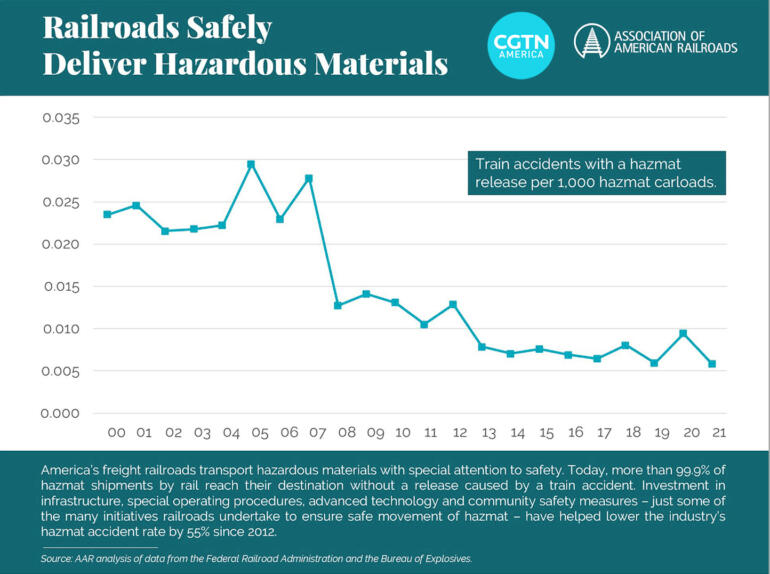On February 3, a 9,300-foot-long freight train transporting hazardous chemicals owned by freight rail operator Norfolk Southern derailed in East Palestine, Ohio.
With the potential for some of those hazardous materials to explode, authorities let the train operator conduct a “controlled explosion” on Feb. 6 that released known carcinogens and a plume of black smoke into the atmosphere.
While residents near the site were evacuated ahead of the explosion, locals and public health advocates are still expressing health concerns amid reports of local waterways that feed into the Ohio River being contaminated by chemicals.

TRAIN.mp4
The latest update on the chemical spill
On Friday, February 24, an independent analysis of Environmental Protection Agency data released its findings of nine air contaminants that have been discovered in East Palestine and the surrounding area that might cause long-term health issues.
The Texas A&M researchers found elevated amounts of chemicals that are known to cause eye and lung irritation, headaches, and other symptoms, as well as others that are known or suspected to cause cancer, in their analysis of EPA data.
This examination contradicts state and federal regulators’ claims that the air close to the crash site is entirely safe.
The Texas A&M researchers found elevated amounts of chemicals that are known to cause eye and lung irritation, headaches, and other symptoms, as well as others that are known or suspected to cause cancer, in their analysis of EPA data.
According to one of the researchers, Weihsueh Chiu, it would take months or perhaps years of exposure to the toxins for major health effects to manifest.
On Friday, EPA representatives made this point clear. They emphasized that the safety threshold used by the researchers to examine the data implies continual exposure over a lifetime and stated that they do not anticipate the pollution to remain at high concentrations for “anywhere near that long.”
What we know about the train crash
On February 3, at around 9 p.m., about 50 out of 150 cars derailed close to the village of East Palestine, Ohio, a community of 4,700 people located just half a mile from Pennsylvania’s border. The cars that were derailed caught fire as a result of the collision.
Eleven of the derailed rail cars contained hazardous materials, some of which are essential for the production of plastics. According to James Lee, a representative for the Ohio Environmental Protection Agency, one of the main pollutants released in the collision was the cancer-causing toxin vinyl chloride.
When vinyl chloride burns, it also produces other chemicals, many of which, according to experts, can be dangerous to people. Dizziness, nausea, headaches, and irritation of the eyes or throat can all result from exposure to these substances.
How Harmful are the chemicals released?
Vinyl chloride is linked to lymphoma, leukemia, and malignancies of the brain and lungs, according to the U.S. National Cancer Institute.
According to one study, workers who were exposed to PVC dust had a considerably increased chance of developing cancer.
One estimate puts the number of compounds used in plastics at around 10,000, including vinyl chloride. Scientists are concerned about more than 2,400 of those compounds because they are either hazardous or linger in the environment and organisms.
Mary Mertz, the Director of the Ohio Department of Natural Resources reported that the Ohio River and other nearby waters became poisoned, resulting in the deaths of around 3,500 fish. Although locals have expressed concerns about chickens, bunnies, foxes, and other animals becoming ill as a result of the leak, state officials claimed they had not found any indication of creatures other than fish suffering from the train incident.
Many of the sampling sites along the Ohio River were found to have low concentrations of the chemical butyl acrylate. The observed concentrations, according to state EPA authorities, pose no threat to the region’s drinking water systems.
How did a toxic chemical like vinyl chloride end up on the derailed Norfolk Southern train?
One of the most popular types of plastic is PVC, which is mostly used in piping but is also used in packaging and everyday items.
According to Judith Enck, head of Beyond Plastics and a former EPA regional administrator, there are around 5,000 companies in the U.S. alone that manufacture various types of plastic.
However, it’s not only vinyl chloride. To give plastic its characteristic features, such as increased heat resistance or flexibility, manufacturers must add a ton of additional chemicals. Several of them are recognized as endocrine-disrupting chemicals, or EDCs, which cause health problems with the body’s hormones.
According to Norfolk Southern, continuous environmental remediation work is being done along with air, soil, and water monitoring in conjunction with state and federal agencies. The derailment has sparked debate over how frequently poisonous and hazardous materials are transported through U.S. communities using train transportation.

How often do these chemicals pass through U.S. railways?
In 2022, around 535 million miles covered across the U.S. resulted in 11 accidents involving the emission of hazardous chemicals, according to data from the Federal Railroad Administration. According to the authorities, only two injuries were reported. Hazardous material discharges reached their ten-year peak in 2018 and 2020, respectively.
With the 30 million goods that railways transport across the nation each year, hazardous materials make up around 7-8% of the total.
 CGTN America
CGTN America

